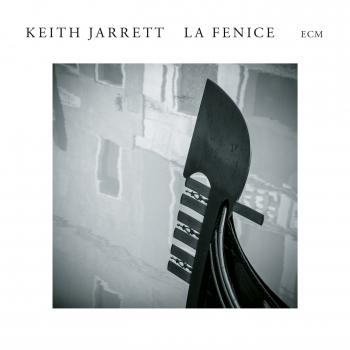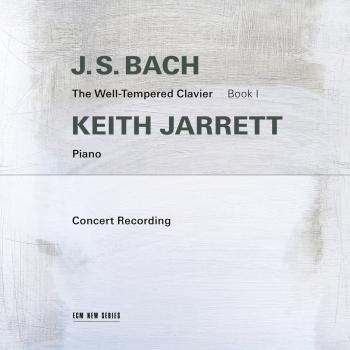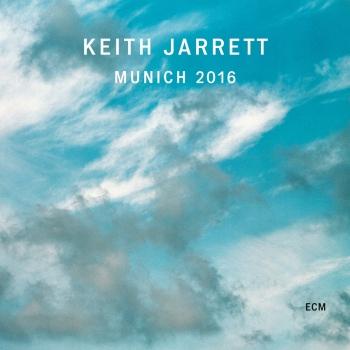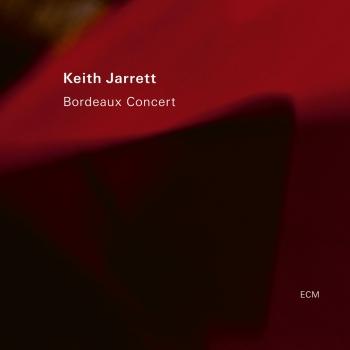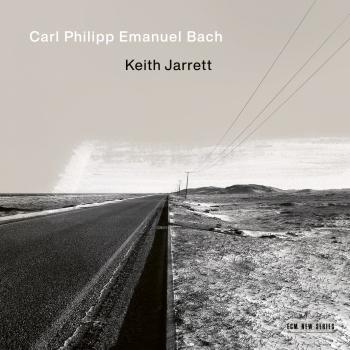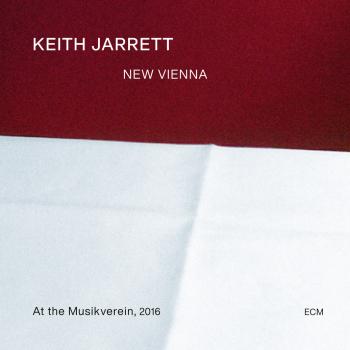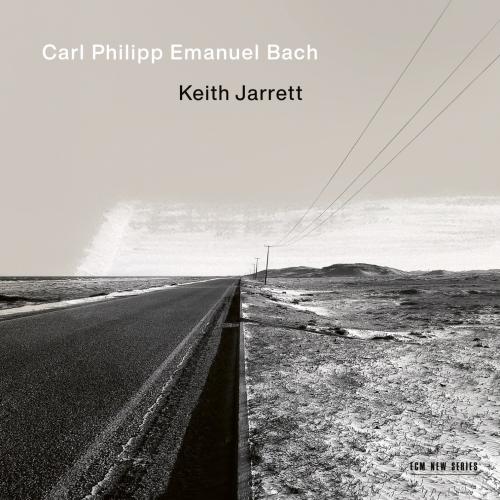
Carl Philipp Emanuel Bach Keith Jarrett
Album info
Album-Release:
2023
HRA-Release:
30.06.2023
Label: ECM New Series
Genre: Classical
Subgenre: Instrumental
Artist: Keith Jarrett
Composer: Carl Philipp Emanuel Bach (1714-1788)
Album including Album cover Booklet (PDF)
I`m sorry!
Dear HIGHRESAUDIO Visitor,
due to territorial constraints and also different releases dates in each country you currently can`t purchase this album. We are updating our release dates twice a week. So, please feel free to check from time-to-time, if the album is available for your country.
We suggest, that you bookmark the album and use our Short List function.
Thank you for your understanding and patience.
Yours sincerely, HIGHRESAUDIO
- Carl Philipp Emanuel Bach (1714 - 1788): Württemberg Sonatas / Sonata No. 1 in A Minor, H. 30:
- 1 Bach: Württemberg Sonatas / Sonata No. 1 in A Minor, H. 30: I. Moderato 07:33
- 2 Bach: Württemberg Sonatas / Sonata No. 1 in A Minor, H. 30: II. Andante 03:15
- 3 Bach: Württemberg Sonatas / Sonata No. 1 in A Minor, H. 30: III. Allegro assai 05:28
- Württemberg Sonatas / Sonata No. 2 in A-Flat Major, H. 31:
- 4 Bach: Württemberg Sonatas / Sonata No. 2 in A-Flat Major, H. 31: I. Un poco allegro 06:51
- 5 Bach: Württemberg Sonatas / Sonata No. 2 in A-Flat Major, H. 31: II. Adagio 03:07
- 6 Bach: Württemberg Sonatas / Sonata No. 2 in A-Flat Major, H. 31: III. Allegro 03:50
- Württemberg Sonatas / Sonata No. 3 in E Minor, H. 33:
- 7 Bach: Württemberg Sonatas / Sonata No. 3 in E Minor, H. 33: I. Allegro 06:01
- 8 Bach: Württemberg Sonatas / Sonata No. 3 in E Minor, H. 33: II. Adagio 03:16
- 9 Bach: Württemberg Sonatas / Sonata No. 3 in E Minor, H. 33: III. Vivace 02:59
- Württemberg Sonatas / Sonata No. 4 in B-Flat Major, H. 32:
- 10 Bach: Württemberg Sonatas / Sonata No. 4 in B-Flat Major, H. 32: I. Un poco allegro 05:47
- 11 Bach: Württemberg Sonatas / Sonata No. 4 in B-Flat Major, H. 32: II. Andante 03:00
- 12 Bach: Württemberg Sonatas / Sonata No. 4 in B-Flat Major, H. 32: III. Allegro 04:30
- Württemberg Sonatas / Sonata No. 5 in E-Flat Major, H. 34:
- 13 Bach: Württemberg Sonatas / Sonata No. 5 in E-Flat Major, H. 34: I. Allegro 07:41
- 14 Bach: Württemberg Sonatas / Sonata No. 5 in E-Flat Major, H. 34: II. Adagio 03:20
- 15 Bach: Württemberg Sonatas / Sonata No. 5 in E-Flat Major, H. 34: III. Allegro assai 03:31
- Württemberg Sonatas / Sonata No. 6 in B Minor, H. 36:
- 16 Bach: Württemberg Sonatas / Sonata No. 6 in B Minor, H. 36: I. Moderato 07:02
- 17 Bach: Württemberg Sonatas / Sonata No. 6 in B Minor, H. 36: II. Adagio non molto 03:43
- 18 Bach: Württemberg Sonatas / Sonata No. 6 in B Minor, H. 36: III. Allegro 04:29
Info for Carl Philipp Emanuel Bach
Keith Jarrett’s account of Carl Philipp Emanuel Bach’s Württemberg Sonatas is a revelation. “I’d heard the sonatas played by harpsichordists, and felt there was a space left for a piano version,” says Jarrett today. This outstanding recording, made in May 1994 and previously unreleased, finds the pianist attuned to the expressive implications of the sonatas in every moment. The younger Bach’s idiosyncrasies: the gentle playfulness of the music, the fondness for subtle and sudden tempo shifts, the extraordinary, rippling invention…all of this is wonderfully delivered. The fluidity of the whole performance has a quality that perhaps could be conveyed only by an artist of great improvisational skills. In Jarrett’s hands, CPE Bach’s exploration of new compositional forms retains the freshness of discovery. The pianist also takes to heart CPE’s famous statement: “Since a musician cannot move others unless he himself is moved, he must of necessity feel all of the affects that he hopes to arouse in his listeners."
Carl Philipp Emanuel Bach’s Württemberg Sonatas were written in 1742-3, and dedicated to Carl Eugen Duke of Württemberg, who studied with CPE at the court of Frederik the Great in Berlin. Published in 1744, they are regarded today as musical masterpieces of the era between the Baroque and the Classical.
Keith Jarrett’s recording of the Württemberg Sonatas followed a period in which he had been focussing on the music of Johann Sebastian Bach. ECM New Series documented Jarrett’s interpretations of Das Wohltemperierte Klavier Buch 1 (recorded February 1987), the Goldberg Variations (January 1989), The French Suites (September1991) and, with Kim Kashkashian, the 3 Sonaten für Viola da Gamba und Cembalo (also September 1991). Other classical recordings made by Jarrett in this period included Shostakovich’s Bach-inspired 24 Preludes and Fugues (recorded July 1991) and Suites for Keyboard by Bach’s contemporary Georg Friedrich Händel (September 1993).
In parallel with all this activity, Jarrett was continuing to work with his improvising trio with Gary Peacock and Jack DeJohnette, raising the bar for interpretive performances of jazz standards. Just three weeks after the CPE Bach recording, the trio was at New York’s Blue Note for an historic three-night run subsequently issued as an award-winning 6-CD box set.
At the year’s end, there was further classical activity, Jarrett playing Mozart Piano Concertos with the Stuttgarter Kammerorchester under the direction of Dennis Russell Davies. It was Mozart who had hailed CPE Bach as “the father of us all,” a musician who brought a new creative freedom to composing for the keyboard.
Keith Jarrett
Keith Jarrett
At the end of 2008, Keith Jarrett added two concerts to his schedule at short notice – one at Paris’s Salle Pleyel (November 26), one at London’s Royal Festival Hall (December 1) . The music on “Testament” is from these concerts. Their range is compendious, Jarrett’s improvisational imagination continually uncovering new forms, in a music stirred by powerful emotions. In his liner notes, the pianist is forthright about the personal circumstances promoting a need to lose himself in the work once more.
He also reminds the reader/listener that “it is not natural to sit at a piano, bring no material, clear your mind completely of musical ideas and play something that is of lasting value and brand new.” This, however, has been the history and substance of the solo concerts since Jarrett initiated them, almost forty years ago . Over time their connection to ‘jazz’ has often become tenuous, yet Jarrett’s solo concerts, with the foregrounding of melody and the continual building, and relinquishing, of structure, are also removed from “free improvisation” as a genre. Jarrett’s solo work is effectively its own idiom, and has been subject to periodic revisions by the pianist. “In the early part of this decade, I tried to bring the format back: starting from nothing and building a universe.”
Since the “Radiance” album and the “Tokyo Solo” DVD of 2002 Jarrett has been adjusting the flow of the work, more often working with shorter blocks of material. “I continued to find a wealth of music inside this open format, stopping whenever the music told me to.” This approach distinguished “The Carnegie Hall Concert” (2006), and it is most effectively deployed in “Testament” , where the strongly-contrasting elements of the sections of the Paris concert in particular have the logic of a spontaneously-composed suite. The nerves-bared London performance (the first UK solo show in 18 years) is different again: “The concert went on and, though the beginning was a dark, searching, multi-tonal melodic triumph, by the end it somehow became a throbbing, never-to-be-repeated pulsing rock band of a concert (unless it was a church service, in which case, Hallelujah!).”
In the end, the improviser does what must be done. As Keith Jarrett said, a long time ago, “If you’re a rock climber, once you’re halfway up the face of the cliff, you have to keep moving, you have to keep going somewhere. And that’s what I do, I find a way.”
These days, however, Jarrett is rationing the number of ascents: there have been less than thirty solo concerts in the last decade, making “Testament” a special event indeed. Two further solo performances are scheduled for 2009 – at the Palais des Beaux Arts in Brussels on October 9, and at Berlin’s Philharmonie on October 12.
Booklet for Carl Philipp Emanuel Bach










